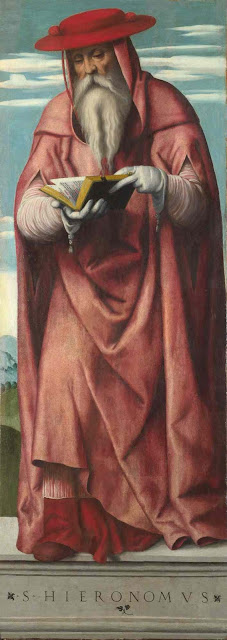 |
| Moretto da Brescia Adoring Angel before 1554 oil on panel National Gallery, London |
 |
| Moretto da Brescia Adoring Angel before 1554 oil on panel National Gallery, London |
 |
| Moretto da Brescia St Jerome before 1554 oil on panel National Gallery. London |
 |
| Moretto da Brescia St Joseph before 1554 oil on panel National Gallery, London |
 |
| Moretto da Brescia Virgin and Child with St Bernardino and other Saints before 1554 oil on canvas National Gallery, London |
 |
| Palma Vecchio Madonna and Child with St John the Baptist and Mary Magdalene ca. 1520-22 oil on panel Musei di Strada Nuova, Genoa |
"What was the religious function of religious pictures? In the Church's view the purpose of images was threefold. John of Genoa's late thirteenth-century Catholicon, still a standard dictionary of the period, summarized them in this way:
Know that there were three reasons for the institution of images in churches. First, for the instruction of simple people, because they are instructed by them as if by books. Second, that the mystery of the incarnation and the examples of the Saints may be the more active in our memory through being presented daily to our eyes. Third, to excite feelings of devotion, these being aroused more effectively by things seen than by things heard.
. . . If you commute these three reasons for images into instructions for the beholder, it amounts to using pictures as respectively lucid, vivid and readily accessible stimuli to meditation on the Bible and the lives of the Saints. If you convert them into a brief for the painter, they carry an expectation that the picture should tell its story in a clear way for the simple and in an eye-catching and memorable way for the forgetful, and with full use of all the emotional resources of the sense of sight, the most powerful as well as the most precise of the senses."
– Michael Baxandall, from Painting and Experience in Fifteenth-century Italy: a primer in the social history of pictorial style (Oxford: Clarendon Press, 1972)
 |
| Palma Vecchio Young woman in a blue dress ca. 1512-14 oil on panel Kunsthistorisches Museum, Vienna |
 |
| Palma Vecchio Portrait of a poet ca. 1516 oil on panel National Gallery, London |
 |
| Palma Vecchio Portrait of blonde woman ca. 1520 oil on panel National Gallery, London |
 |
| Titian Holy Family with Shepherd ca. 1510 oil on canvas National Gallery, London |
 |
| Titian Noli me tangere ca. 1514 oil on canvas National Gallery, London |
Ask me no more: the moon may draw the sea;
The cloud may stoop from heaven and take the shape,
With fold to fold, of mountain or of cape;
But O too fond, when have I answer'd thee?
Ask me no more.
Ask me no more: what answer should I give?
I love not hollow cheek or faded eye:
Yet, O my friend, I will not have thee die!
Ask me no more, lest I should bid thee live;
Ask me no more.
Ask me no more: thy fate and mine are seal'd:
I strove against the stream and all in vain:
Let the great river take me to the main:
No more, dear love, for at a touch I yield;
Ask me no more.
– from The Princess (1847) by Alfred, Lord Tennyson
 |
| Titian Madonna and Child with St John the Baptist and female saint or donor (Aldobrandini Madonna) ca. 1532 oil on canvas National Gallery, London |
 |
| Titian Ecce Homo 1543 oil on canvas Kunsthistorisches Museum, Vienna |
 |
| Titian Vendramin family venerating a relic of the True Cross ca. 1540-45 oil on canvas National Gallery, London |